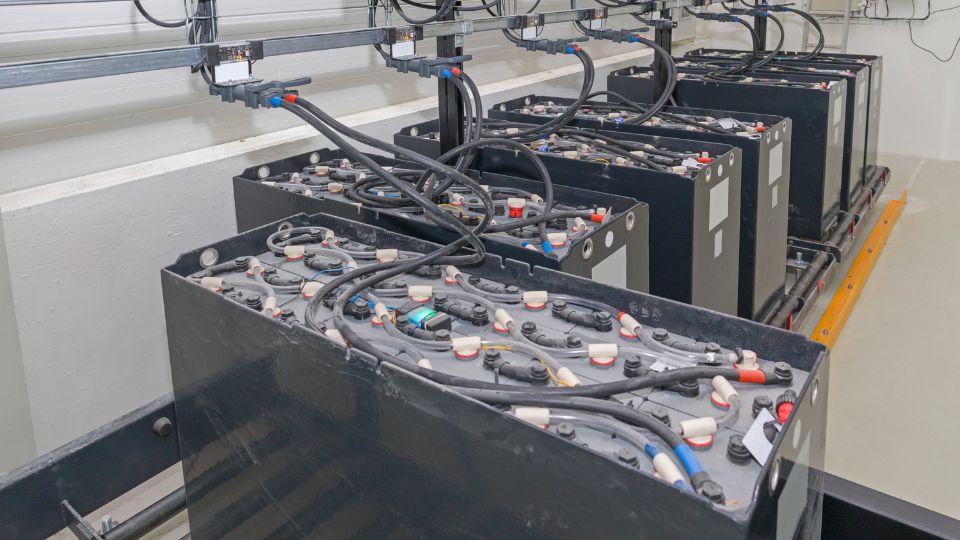In the modern era, with the rise of industrial and electric vehicles (EVs), the importance of efficient battery warehousing and storage cannot be overstated. Batteries serve as the lifeblood of these vehicles, powering their operations and driving the transition towards sustainable transportation solutions. However, improper handling and storage of batteries can lead to safety hazards, reduced performance, and premature degradation. Therefore, it’s crucial for industries and EV manufacturers alike to adhere to best practices in battery warehousing and storage. In this comprehensive guide, we’ll delve into everything you need to know to ensure the proper handling and storage of industrial and EV batteries.
Understanding the different types of batteries
Batteries are at the heart of modern industrial machinery and electric vehicles (EVs), providing the necessary power for operation. Understanding the different types of batteries and their characteristics is crucial for efficient storage and maintenance practices. Here’s a detailed look at the two primary battery types:
Lead-acid batteries
Lead-acid batteries have been a cornerstone of industrial applications for decades. They are known for their robustness, reliability, and relatively low cost compared to other battery technologies. These batteries consist of lead plates immersed in a sulfuric acid electrolyte solution. During operation, lead sulfate forms on the plates as the battery discharges, and this process reverses during charging.
Lead-acid batteries are characterized by their ability to deliver high current outputs, making them suitable for applications requiring a burst of power, such as starting engines or operating heavy machinery. However, they have limitations in terms of energy density and cycle life compared to newer battery technologies like lithium-ion.
Despite their drawbacks, lead-acid batteries remain popular in industrial settings due to their affordability and familiarity. They are commonly used in forklifts, industrial cleaning equipment, backup power systems, and other heavy-duty applications where cost-effectiveness and reliability are prioritized.
Lithium-ion batteries
Lithium-ion batteries have revolutionized the EV industry and are increasingly finding applications in industrial machinery and equipment. These batteries utilize lithium ions as the charge carriers, allowing for high energy density and longer cycle lift compared to lead-acid batteries.
Lithium-ion batteries come in various chemistries, including lithium cobalt oxide (LCO), lithium iron phosphate (LFP), lithium manganese oxide (LMO), and lithium nickel cobalt aluminum oxide (NCA). Each chemistry offers a unique balance of energy density, safety, and cost, making them suitable for different applications.
EVs rely heavily on lithium-ion batteries due to their lightweight design, high energy density, and fast charging capabilities. In industrial settings, lithium-ion batteries are preferred for applications requiring long runtime, such as material handling equipment, aerial work platforms, and electric utility vehicles.
However, lithium-ion batteries require careful handling and monitoring due to safety concerns associated with thermal runaway events, which can lead to fire or explosion. Proper storage and charging practices are essential to mitigate these risks and ensure the safe operation of lithium-ion battery systems.
What are the factors you should consider when storing batteries?
Proper storage conditions play a crucial role in maintaining the performance, safety, and longevity of industrial and EV batteries. Several key factors influence the storage requirements for these batteries:
Temperature control
Temperature is perhaps the most critical factor affecting battery storage. Extreme temperatures, whether too hot or too cold, can have detrimental effects on battery performance and lifespan. High temperatures accelerate chemical reactions within the battery, leading to increased self-discharge and accelerated degradation of active materials. Conversely, low temperature can reduce battery capacity and slow down chemical reactions, impeding performance.
Ideally, batteries should be stored in a controlled environment with stable temperatures. The recommended storage temperature varies depending on the battery chemistry but generally falls within the range of 15 to 25 degrees celsius (59 to 77 Fahrenheit. Extreme temperature fluctuations should be avoided to prevent thermal stress on the battery, which can lead to internal damage and reduced lifespan.
Humidity management
Humidity levels in the storage environment can also impact battery performance and safety. High humidity can promote corrosion of metal components and lead to moisture ingress, which may cause electrical short circuits and degrade battery performance. On the other hand, excessively dry conditions can accelerate the aging of battery seals and increase the risk of electrolyte leakage.
Maintaining optimal humidity levels is essential to prevent moisture-related damage to batteries. The recommended relative humidity for battery storage typically ranges from 30% to 50%. Humidity control measures such as dehumidifiers or desiccants may be employed to regulate moisture levels within the storage facility.
Ventilation and airflow
Adequate ventilation is crucial for dissipating heat generated during battery charging and discharging operations. Proper airflow helps maintain a uniform temperature distribution within the storage area, preventing localized hot spots that can accelerate battery degradation. In addition to temperature regulation, ventilation also helps disperse any of-gassing of volatile compounds that may occur during battery operation.
Storage facilities should be equipped with sufficient ventilation systems to ensure continuous airflow throughout the space. Natural ventilation through windows or vents, supplemented by mechanical ventilation systems if necessary, can help maintain optimal storage conditions for batteries.
Safety regulations compliance
Compliance with safety regulations and guidelines is paramount to ensure a safe working environment and prevent accidents. Regulatory bodies such as OSHA (Occupational Safety and Health Administration) provide guidelines for the storage and handling of hazardous materials, including batteries. These regulations may include requirements for storage facility design, fire protection measures, emergency response procedures, and employee training.
Businesses must stay abreast of relevant safety regulations and ensure that their battery storage practice align with applicable standards. Regular safety inspections and audits can help identify potential hazards and ensure compliance with regulatory requirements.
Best practices for battery storage
Ensuring the proper storage of batteries is essential for maintaining their performance, safety, and longevity. Here are comprehensive best practices to follow.
Segregation and classification
Segregate batteries based on chemistry type, size, and state of charge to prevent cross-contamination and mitigate potential safety hazards. Classify batteries according to their chemistry (e.g., lead-acid, lithium-ion) and designate separate storage areas for each type.
Additionally, categorize batteries based on their state of charge (SOC) to minimize the risk of accidental short circuits. Fully charged and fully discharged batteries should be stored separately to prevent potential overcharging or reverse charging incidents.
Proper labeling and documentation
Clearly label each battery with pertinent information such as chemistry type, manufacturing date, state of charge, and any special handling instructions. Use durable and weather-resistant labels that are easy to read and withstand the storage environment.
Maintain comprehensive documentation of all stored batteries, including inventory records, maintenance logs, and safety data sheets (SDS). This documentation helps track battery usage, monitor performance, and ensure compliance with regulatory requirements.
Racking systems and storage infrastructure
Utilize appropriate racking systems and storage infrastructure designed to accommodate the weight and dimensions of batteries. Select racks made from non-conductive materials to minimize the risk of electrical shorts and corrosion.
Ensure adequate spacing between batteries to allow for proper ventilation and ease of access during inspection and maintenance activities. Implement secure anchoring systems to prevent racks from tipping over or collapsing under load.
Designated charging stations
Establish designated charging stations within the storage facility equipped with proper ventilation, fire suppression systems, and charging infrastructure compliant with relevant safety standards. Segregate charging areas from storage areas to minimize the risk of fire or explosion.
Implement charging protocols that follow manufacturer recommendations and industry best practices. Avoid overcharging or rapid charging batteries beyond their rated capacity to prevent thermal runaway events and premature degradation.
Regular inspections and maintenance
Implement routine inspections of stored batteries to identify signs of damage, leaks, or degradation early on. Develop standardized inspection checklists and procedures to ensure a thorough examination of each battery.
Conduct periodic maintenance activities such as cleaning, terminal tightening, and electrolyte level checks to ensure optimal performance and prevent corrosion. Replace damaged or deteriorating batteries promptly to prevent safety risks and ensure uninterrupted operations.
Employee training and safety protocols
Provide comprehensive training to employees involved in battery handling and storage. Offer instruction on safety protocols, emergency response procedures, and proper handling techniques to mitigate risks effectively.
Emphasize the importance of personal protective equipment (PPE) such as gloves, safety goggles, and protective clothing when working with batteries. Encourage a culture of safety awareness and empower employees to report any safety concerns or incidents promptly.
Environmental considerations in battery storage
In addition to safety and performance concerns, it’s crucial to address environmental considerations when storing industrial and electric vehicle batteries. Here’s a detailed look at key environmental factors:
Recycling and disposal practices
Proper disposal and recycling of end-of-life batteries are essential to minimize environmental impact and comply with regulatory requirements. Batteries contain various hazardous materials, including heavy metals and toxic chemicals, which can leach into soil and water if not handled responsibly.
Establish protocols for the collection, transportation, and recycling of spent batteries. Partner with certified recycling facilities that specialize in battery recycling and adhere to strict environmental standards. Implement a closed-loop recycling system wherever possible to recover valuable materials and reduce the need for virgin resources.
Educate employees and stakeholders on the importance of battery recycling and provide convenient collection points within the facility to encourage participation and compliance.
Energy efficiency measures
Implement energy-efficient practices and technologies within the battery storage facility to reduce carbon emissions and minimize environmental footprint. Consider upgrading to energy-efficient lighting systems, such as LED fixtures, and installing programmable thermostats to optimize HVAC energy consumption.
Conduct energy audits to identify areas for improvement and implement energy-saving measures such as insulation upgrades, air sealing, and equipment optimization. Utilize renewable energy sources such as solar or wind power to supplement energy needs for battery charging and storage operations.
Monitor energy usage and track progress towards energy efficiency goals using smart metering and energy management systems. Engage employees in energy conservation efforts through awareness campaigns and incentives to promote a culture of sustainability.
Waste reduction and resource conservation
Implement waste reduction strategies to minimize the generation of non-recyclable waste and conserve natural resources. Optimize packaging materials and storage practices to reduce packaging waste and improve resource efficiency.
Explore opportunities for reusing or repurposing batteries that have reached the end of their operational life but still retain some residual capacity. Repurpose spent batteries for secondary applications such as energy storage systems for renewable energy projects or backup power sources for critical infrastructure.
Implement a comprehensive waste management program that includes waste segregation, recycling, and composting initiatives. Educate employees on proper waste handling procedures and provide recycling bins and signage to facilitate proper disposal.
Utilizing Third-Party Logistics (3PL) for battery storage
Engaging third-party logistics providers specialized in battery storage and management can offer several benefits, particularly for businesses with limited storage capacity or specific regulatory requirements. 3PL companies equipped with dedicated facilities and expertise in handling batteries can provide a range of services tailored to the unique needs of industrial and electric vehicle battery storage.
Partnering with a reputable 3PL provider offers flexibility in scaling storage capacity according to demand fluctuations without the need for significant upfront investment in infrastructure. These provides often offer customizable storage solutions, including temperature-controlled environments, secure racking systems, and comprehensive inventory management systems.
3PL providers can also assist in navigating complex regulatory requirements and compliance standards governing battery storage and transportation. With their industry knowledge and experience, they can ensure adherence to safety protocols, environmental regulations, and handling guidelines, minimizing the risk of compliance violations and associated penalties.
Additionally, outsourcing battery storage to a 3PL provider allows businesses to focus on their core competencies while leveraging the provider’s specialized capabilities and resources. This can result in improved operational efficiency, reduced overhead costs, and enhanced supply chain resilience.
Before selecting a 3pL provider, businesses should conduct thorough due diligence to assess the provider’s track record, certifications, and reputation within the industry. It’s essential to establish clear communication channels, service-level agreements, and performance metrics to ensure alignment with business objectives and expectations.
By leveraging the expertise and infrastructure of a trusted 3PL partner, businesses can streamline their battery storage operations, mitigate risks, and optimize resource utilization, ultimately driving greater value and competitiveness in the marketplace.
Conclusion
Proper warehousing and storage of industrial and electric vehicle batteries are critical for ensuring safety, longevity, and optimal performance. By adhering to best practices and regulatory guidelines, businesses can mitigate risks, minimize environmental impact, and maximize the lifespan of their battery assets. Investing in robust storage infrastructure, implementing rigorous safety protocols, and fostering a culture of environmental responsibility will pave the way for a sustainable future in battery technology.
In conclusion, the proper warehousing and storage of batteries are vital for ensuring safety, longevity, and optimal performance in industrial and electric vehicle applications. By following the best practices and staying abreast of technological advancements, businesses can maximize the value of their battery assets while minimizing risks and environmental impact.











